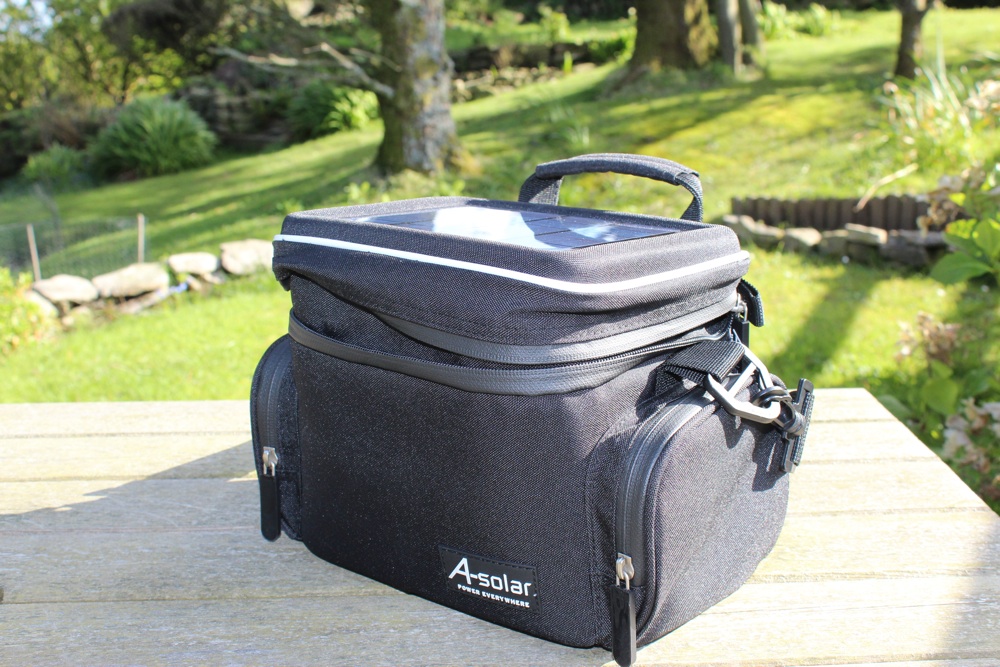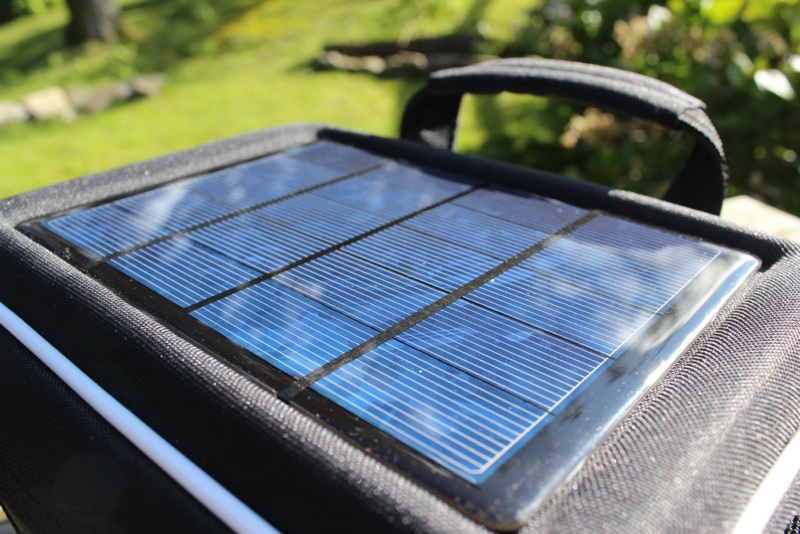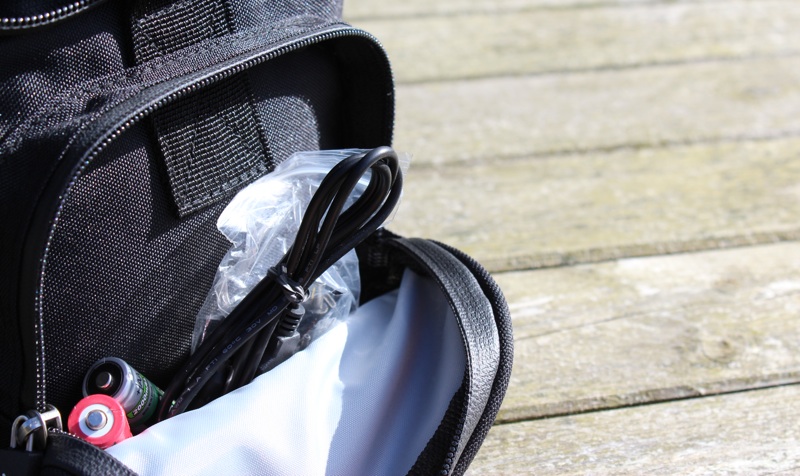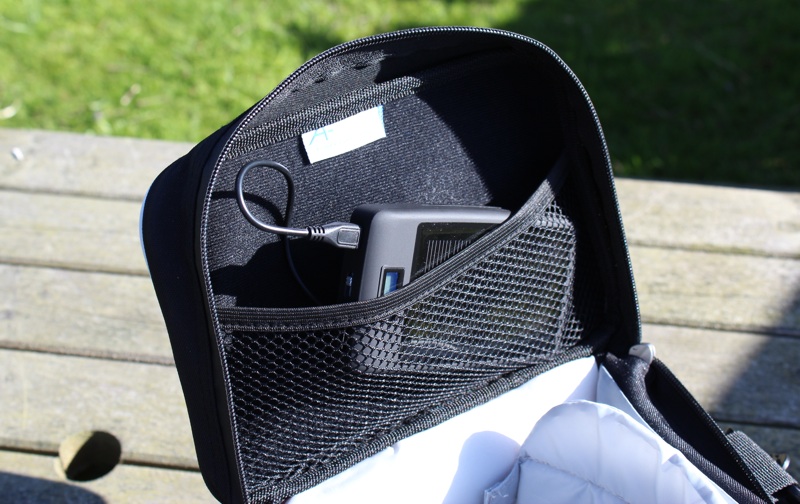A-Solar Aurora Camera Bag Review
 The A-Solar Aurora may look like an ordinary camera bag but one of its unique abilities could be a saviour for avid photographers.
The A-Solar Aurora may look like an ordinary camera bag but one of its unique abilities could be a saviour for avid photographers.
It sports a ginormous solar panel on top of the lid which practically covers the surface area entirely. A-Solar proudly claim that this is the first ever camera bag to include such a feature. The panel is protected via a thin plastic coating. We reveal how well it works later on.
 The bag's build is very solid and thick. The soft padding is substantial and adds a layer of protection to the internal contents. The bag's exterior is splash proof and made from a high quality material which is the end result of recycled PET-Bottles and it hasn't shown any signs of depreciation from our two plus months worth of usage. Even catching the bag on bushes and animal claws, such as that of a dog or cat, won't be evident on the bag.
The bag's build is very solid and thick. The soft padding is substantial and adds a layer of protection to the internal contents. The bag's exterior is splash proof and made from a high quality material which is the end result of recycled PET-Bottles and it hasn't shown any signs of depreciation from our two plus months worth of usage. Even catching the bag on bushes and animal claws, such as that of a dog or cat, won't be evident on the bag.
 This is partly down to the colour of the material which is black, it hides dirt well, too. However, black is the only colour the Aurora is currently available in and we feel a few more colour options wouldn't go amiss. On the bottom of the bag are four rubber feet, these hold the bag above the ground, preventing the underneath material from touching the ground directly. The overall look of the bag is what we'd describe as boxy - it is quite smart though.
This is partly down to the colour of the material which is black, it hides dirt well, too. However, black is the only colour the Aurora is currently available in and we feel a few more colour options wouldn't go amiss. On the bottom of the bag are four rubber feet, these hold the bag above the ground, preventing the underneath material from touching the ground directly. The overall look of the bag is what we'd describe as boxy - it is quite smart though.
 A-Solar have incorporated two methods in the way of carrying the bag around. There is the adjustable shoulder strap which can be disconnected from the bag and the other carrying method is the fixed handle on the top. The shoulder strap features a padded area where it rests on the shoulder for comfort, we have no complaints in terms of how the bag felt to hold. It rested gently against the body because of the material and the lack of extruding elements that could dig into the body after prolonged carrying.
A-Solar have incorporated two methods in the way of carrying the bag around. There is the adjustable shoulder strap which can be disconnected from the bag and the other carrying method is the fixed handle on the top. The shoulder strap features a padded area where it rests on the shoulder for comfort, we have no complaints in terms of how the bag felt to hold. It rested gently against the body because of the material and the lack of extruding elements that could dig into the body after prolonged carrying.
 On the left and right sides of the bag are zipped pockets. Ideal for keeping things like camera remotes, small external microphones, cables, batteries, lens filters and so on. Two single zips are used to open the bag up and gain access to the inside where we find two removable velcro sections. The reason for this design is so the user can adjust the area around the dimensions of the camera to encompass a secure and well padded fit. We found this most useful when using different shaped DSLRs and video cameras and noticed that the Velcro sections remained in place when carrying the bag around in general day to day usage. Depending on the layout of the Velcro sections some free space may be included on the left and/or right hand side for additional storage. The right hand side within the interior has a tight pocket, useful for storing smaller items like memory cards.
On the left and right sides of the bag are zipped pockets. Ideal for keeping things like camera remotes, small external microphones, cables, batteries, lens filters and so on. Two single zips are used to open the bag up and gain access to the inside where we find two removable velcro sections. The reason for this design is so the user can adjust the area around the dimensions of the camera to encompass a secure and well padded fit. We found this most useful when using different shaped DSLRs and video cameras and noticed that the Velcro sections remained in place when carrying the bag around in general day to day usage. Depending on the layout of the Velcro sections some free space may be included on the left and/or right hand side for additional storage. The right hand side within the interior has a tight pocket, useful for storing smaller items like memory cards.
 When the A-Solar Aurora Camera Bag is purchased, another boxed charger called the A-Solar Solar Quartz Charger is also included. This is a portable battery pack which has the ability to charge camera 3.7V-7.4V battery packs and AA/AAA batteries, and has a USB power out. Included within the box of this charger is a USB cable that is compatible with eight different interchangeable connectors to allow the charging of a very wide range of devices. No Apple 30 pin or Lightning connector is included but if you keep the charging cables with you, you can plug them into the USB 2.0 connection. Switching from different charging modes is achieved via a sliding switch. We found the switch very difficult to slide to the mode we wanted because it is so loose and quickly skips over the modes in the middle section. At the bottom of the front of the Quartz Charger is an LED screen which shows the mode it is in and the charging status; this has a backlight when enough power is either stored or being drawn from the sun. The internal battery stores 1,800mAh, in real world use this will fully charge a Canon 600D (T3i's) or a Nikon D5100 battery and have some juice left over in the tank. The maximum output is 5v/ 1A, enough to charge an iPad if the maximum output is reached, which is achievable on sunny days.
When the A-Solar Aurora Camera Bag is purchased, another boxed charger called the A-Solar Solar Quartz Charger is also included. This is a portable battery pack which has the ability to charge camera 3.7V-7.4V battery packs and AA/AAA batteries, and has a USB power out. Included within the box of this charger is a USB cable that is compatible with eight different interchangeable connectors to allow the charging of a very wide range of devices. No Apple 30 pin or Lightning connector is included but if you keep the charging cables with you, you can plug them into the USB 2.0 connection. Switching from different charging modes is achieved via a sliding switch. We found the switch very difficult to slide to the mode we wanted because it is so loose and quickly skips over the modes in the middle section. At the bottom of the front of the Quartz Charger is an LED screen which shows the mode it is in and the charging status; this has a backlight when enough power is either stored or being drawn from the sun. The internal battery stores 1,800mAh, in real world use this will fully charge a Canon 600D (T3i's) or a Nikon D5100 battery and have some juice left over in the tank. The maximum output is 5v/ 1A, enough to charge an iPad if the maximum output is reached, which is achievable on sunny days.
 You may be wondering why the Quartz charger is included. Well, the reason for this is because the bag only has a micro USB cable tucked into its lid, meaning the bag itself will charge devices from sunlight only if they have a micro USB input for charging. We have tested this out on a few micro USB devices we have lying around the studio and it charged them with no difficulties. Of course, the micro USB is a tad redundant for use with DSLR and video cameras, most don't allow the charging via USB and require the battery pack to be removed and charged via a wall outlet dock.
You may be wondering why the Quartz charger is included. Well, the reason for this is because the bag only has a micro USB cable tucked into its lid, meaning the bag itself will charge devices from sunlight only if they have a micro USB input for charging. We have tested this out on a few micro USB devices we have lying around the studio and it charged them with no difficulties. Of course, the micro USB is a tad redundant for use with DSLR and video cameras, most don't allow the charging via USB and require the battery pack to be removed and charged via a wall outlet dock.
 However, by pairing the Quartz charger with the Aurora Camera Bag we can then charge other batteries, such as that on the DSLR, with the micro USB cable from the camera bag plugged into the Quartz Charger. The process of charging is then a joint venture between one small and one giant solar panel, with a peaking transfer rate of 2.7 watts. But to our surprise we didn't see any very noticeable differences when charging with both or just the bag's own solar panel. Charging generally took longer than that of mains electricity by an additional time of 30-40%; shown from our tests on reasonably sunny days with temperatures of 14-20 degrees Celsius and, most importantly, clear blue skies. The bag also charges on dull and cloudy days but the process is much slower, and it even charges indoors when the solar panel is very close to a light.
However, by pairing the Quartz charger with the Aurora Camera Bag we can then charge other batteries, such as that on the DSLR, with the micro USB cable from the camera bag plugged into the Quartz Charger. The process of charging is then a joint venture between one small and one giant solar panel, with a peaking transfer rate of 2.7 watts. But to our surprise we didn't see any very noticeable differences when charging with both or just the bag's own solar panel. Charging generally took longer than that of mains electricity by an additional time of 30-40%; shown from our tests on reasonably sunny days with temperatures of 14-20 degrees Celsius and, most importantly, clear blue skies. The bag also charges on dull and cloudy days but the process is much slower, and it even charges indoors when the solar panel is very close to a light.
 Because having both panels displayed to the sun generally made little difference and would be a terrible nuisance, we didn't leave the Quartz's solar panel visible to the sun when charging our camera batteries and other items. We left it tucked inside a net found under the lid, which made the charging far more convenient as we could zip it up and just walk around with the bag outdoors like any other camera bag. This is clearly the intended method to use the Aurora and it's convenient, but the whole setup could be designed better. Having a confident charging solution that even works in cloudy weather is reassuring when stranded from any nearby wall outlets and if it begins to go dark you have the additional backup energy source stored in the Quartz Charger.
Because having both panels displayed to the sun generally made little difference and would be a terrible nuisance, we didn't leave the Quartz's solar panel visible to the sun when charging our camera batteries and other items. We left it tucked inside a net found under the lid, which made the charging far more convenient as we could zip it up and just walk around with the bag outdoors like any other camera bag. This is clearly the intended method to use the Aurora and it's convenient, but the whole setup could be designed better. Having a confident charging solution that even works in cloudy weather is reassuring when stranded from any nearby wall outlets and if it begins to go dark you have the additional backup energy source stored in the Quartz Charger.
Overall we admired and enjoyed the A-Solar Aurora Camera Bag. It's a great standalone camera bag but the addition of the solar panel is the cherry on the cake, although the execution of this works well, it could be made simpler. Nevertheless, it's a step in the right direction.

